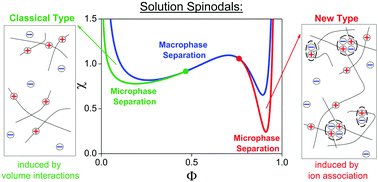当前位置:
X-MOL 学术
›
Soft Matter
›
论文详情
Our official English website, www.x-mol.net, welcomes your feedback! (Note: you will need to create a separate account there.)
Two regions of microphase separation in ion-containing polymer solutions
Soft Matter ( IF 3.4 ) Pub Date : 2017-09-04 00:00:00 , DOI: 10.1039/c7sm01340j Artem M. Rumyantsev 1, 2, 3, 4 , Elena Yu. Kramarenko 1, 2, 3, 4
Soft Matter ( IF 3.4 ) Pub Date : 2017-09-04 00:00:00 , DOI: 10.1039/c7sm01340j Artem M. Rumyantsev 1, 2, 3, 4 , Elena Yu. Kramarenko 1, 2, 3, 4
Affiliation

|
The phenomenon of spinodal decomposition in weakly charged polyelectrolyte solutions is studied theoretically within the random phase approximation. A novel feature of the theoretical approach is that it accounts for the effects of ionic association, i.e. ion pair and multiplet formation between counterions and ions in polymer chains, as well as the dependence of local dielectric permittivity on the polymer volume fraction Φ. The main focus is on the spinodal instability of polyelectrolyte solutions towards microscopic phase separation. It has been shown that increasing the binding energy of ions decreases the classical microphase separation region (possible at low polymer concentrations) due to the effective neutralization of the chains. A qualitatively new type of microphase separation is found in the presence of a dielectric mismatch between polymer and solvent. This new branch of microphase separation is realized at high polymer concentrations where ion association processes are the most pronounced. Typical microstructures are shown to have a period of a few nanometers like in ionomers. The driving force for the microphase formation of a new type is more favourable ion association in polymer-rich domains where ionomer-type behavior takes place. Effective attraction due to ion association promotes microscopic as well as macroscopic phase separation, even under good solvent conditions for uncharged monomer units of polymer chains. Polyelectrolyte-type behavior at low Φ and ionomer-type behavior at high Φ result in the presence of two critical points on the phase diagrams of polyelectrolyte solutions as well as two separate regions of possible microscopic structuring. Our predictions on the new type of microphase separation are supported by experimental data on polymer solutions, membranes and gels.
中文翻译:

含离子聚合物溶液中的两个微相分离区域
理论上在随机相近似内研究了弱电荷聚电解质溶液中的旋节线分解现象。该理论方法的一个新颖特征是,它解决了离子缔合的影响,即聚合物链中抗衡离子和离子之间离子对和多重态的形成,以及局部介电常数对聚合物体积分数Φ的依赖性。主要关注于聚电解质溶液在微观相分离方面的旋节线不稳定性。已经表明,由于链的有效中和,增加离子的结合能会减小经典的微相分离区域(在低聚合物浓度下可能)。在聚合物和溶剂之间存在介电不匹配的情况下,发现了一种定性的新型微相分离。这种微相分离的新分支是在离子缔合过程最为明显的高聚合物浓度下实现的。与离聚物一样,典型的微结构显示出具有几纳米的周期。新型微相形成的驱动力是发生离聚物型行为的富含聚合物的区域中更有利的离子缔合。即使在良好的溶剂条件下,对于聚合物链的不带电荷的单体单元,由于离子缔合而产生的有效吸引也会促进微观和宏观相分离。低聚电解质型行为Φ和高Φ的离聚物型行为导致在聚电解质溶液相图上存在两个临界点以及可能的微观结构的两个独立区域。我们对新型微相分离的预测得到了有关聚合物溶液,膜和凝胶的实验数据的支持。
更新日期:2017-09-20
中文翻译:

含离子聚合物溶液中的两个微相分离区域
理论上在随机相近似内研究了弱电荷聚电解质溶液中的旋节线分解现象。该理论方法的一个新颖特征是,它解决了离子缔合的影响,即聚合物链中抗衡离子和离子之间离子对和多重态的形成,以及局部介电常数对聚合物体积分数Φ的依赖性。主要关注于聚电解质溶液在微观相分离方面的旋节线不稳定性。已经表明,由于链的有效中和,增加离子的结合能会减小经典的微相分离区域(在低聚合物浓度下可能)。在聚合物和溶剂之间存在介电不匹配的情况下,发现了一种定性的新型微相分离。这种微相分离的新分支是在离子缔合过程最为明显的高聚合物浓度下实现的。与离聚物一样,典型的微结构显示出具有几纳米的周期。新型微相形成的驱动力是发生离聚物型行为的富含聚合物的区域中更有利的离子缔合。即使在良好的溶剂条件下,对于聚合物链的不带电荷的单体单元,由于离子缔合而产生的有效吸引也会促进微观和宏观相分离。低聚电解质型行为Φ和高Φ的离聚物型行为导致在聚电解质溶液相图上存在两个临界点以及可能的微观结构的两个独立区域。我们对新型微相分离的预测得到了有关聚合物溶液,膜和凝胶的实验数据的支持。



























 京公网安备 11010802027423号
京公网安备 11010802027423号